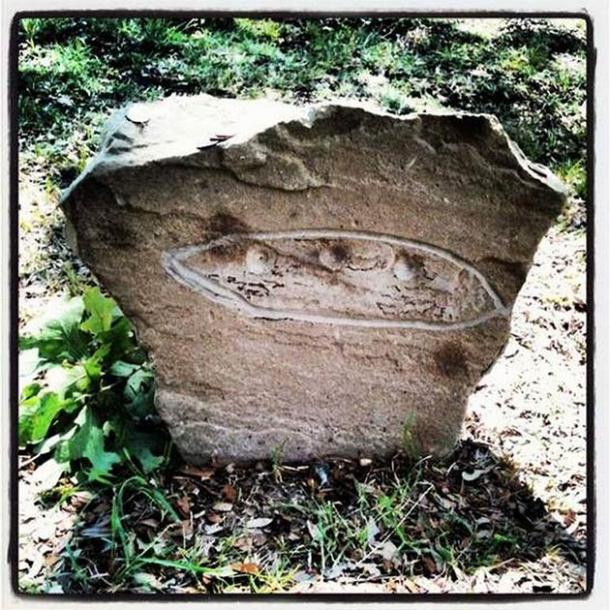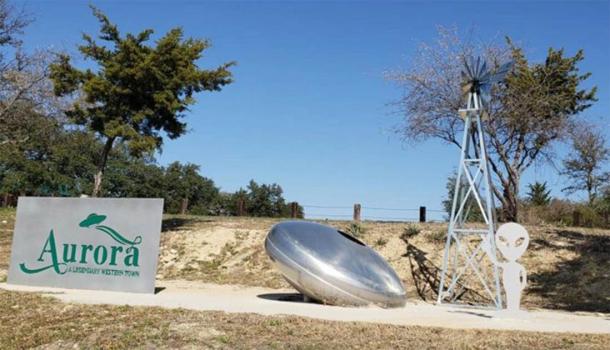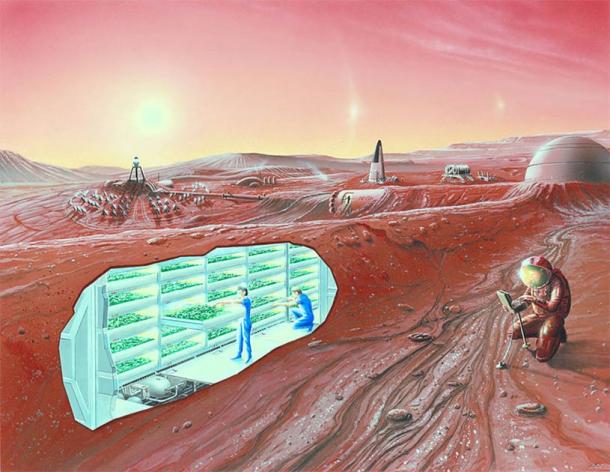The most famous early example of a story about a UFO crash landing is the Roswell incident of 1947. This event is known to have helped spark the modern UFO subculture and the idea that Earth is being regularly visited by intelligent beings. A less well-known example is one which happened 50 years earlier in a town in northern Texas in 1897. It is referred to as the Aurora incident. Although most investigators dismiss the Aurora airship incident as a hoax, it is still celebrated by some UFO enthusiasts as an early example of a UFO sighting and crash landing.
The Aurora Airship Incident
According to the Dallas Morning News, on April 19, 1897, an airship was seen in the early morning hours in the small town of Aurora, Texas. It was cigar-shaped and only moving at about 10 miles (16 km) per hour. Observers in the town watched the vehicle slowly drift across town until it flew over Judge J.S. Proctor’s property.
This is where catastrophe struck as the airship collided with a windmill, causing an explosion. After the explosion settled, the townspeople looked through the wreckage and recovered the pilot. Then the story gets particularly strange.
The pilot was described as badly disfigured, but recognizably non-human. Also, the pilot had papers with him that were written in unidentifiable hieroglyphs. The witnesses reported that the pilot was “not an inhabitant of this world.”
T.J. Weems, a local signal service officer and a person described as an “authority on astronomy,” suggested that the individual might be from the planet Mars. The next day, the pilot was given a “Christian burial” and a tombstone was placed over the grave.
On the tombstone, a crude drawing of the pilot’s vehicle was made. This tombstone was allegedly stolen in 1973, so there is no evidence of the tombstone and no information about where the pilot was buried. In 2008, the makers of an episode of a show called UFO Hunters found an unmarked grave which the producers thought could be the grave of the pilot . However, they were not allowed to exhume the grave so there is no way of knowing if the unmarked grave contained the remains of any pilot, let alone an alien pilot.

Photo of the Aurora UFO alien grave marker. ( City of Aurora )
Plausibility of the Story
Although the Aurora airship incident only became widely known in the late 1960s and early 1970s, the event is considered the original Roswell incident by some within the UFO community. The problem with this conclusion is that there is scant evidence that the incident in Aurora even took place, let alone that it involved a crashed alien spaceship.
In the 1970s, investigators interviewed people who had been alive at the time of the incident. They revealed notable inconsistencies in the narrative. One example of these inconsistencies is that the airship was supposed to have hit a windmill on Judge J.S. Proctor’s farm. There was, however, no windmill on his farm at the time that the collision was supposed to have happened.
Furthermore, there is no evidence of personal records related to the event, such as bills for removal of debris material, or any records of the pilot’s body being placed in the Aurora cemetery. Also, there are no museums, historical societies, or private individuals that have any examples of the pieces of the debris or the writings they supposedly found on the pilot’s person containing alien hieroglyphs.
Additionally, the supposed authority on Astronomy, T.J. Weems, was not a signal service officer but the town blacksmith. These problems cast doubt on the validity of the story. The conclusion of journalists and historians investigating the event is that the Aurora airship incident was probably a hoax made up to create more publicity and tourism for a town that was dying.

Was the Aurora airship incident a hoax made up to create more publicity and tourism? ( Facebook/Eric Shirey )
Alternative Explanations
Sceptics say that it is a hoax, while UFO believers are more likely to believe that it happened. There is, however, a third possibility. It could be that the story was based on a real event in which an airship with a human pilot crashed near the town and the pilot was so badly disfigured by the crash that they didn’t recognize him as a human being .
Airships and balloons go back much farther in history than other aircraft, such as airplanes. The earliest example of a functional airship was probably the one used by Jean Pierre Blanchard to cross the English Channel in 1784. He was able to control its flight by using a hand-powered propeller. The first steam-powered airship was made by Henri Gifford in 1852.
By the 1870s, airships powered by an internal combustion engine had already been developed. Airships were not new to Western culture by the 1890s, but it is possible that people from remote, rural parts of the United States, which described northern Texas at the time, were unfamiliar with airship technology. It is also possible that an airship being tested in the area could have been mistaken by unaccustomed locals as being of extra-terrestrial origin .

S. E. Haydon, “A Windmill Demolishes It,” The Dallas Morning News, April 19, 1897, p. 5. ( Public Domain )
Even if the Aurora airship incident were a complete hoax, the advent of airships would have certainly influenced the development of this narrative.
‘Mars Fever’ and the Aurora Incident
Another interesting aspect of the story that connects it to the wider culture at the time is the fact that the first guess of the account’s “expert on astronomy” was that the pilot was from the planet Mars. At the time, many people, including more scientifically minded individuals, believed that Mars was likely to have life .
In the 18th century, astronomers had confirmed that Mars had seasons. By the 1860s, this seasonal difference in the appearance of Mars was being attributed to differences in vegetation by astronomers. This explanation turned out to be erroneous of course. The visible seasonal differences on Mars have to do with global dust storms and seasonal sublimation of the Martian ice caps, not vegetation.
Another discovery that caused excitement about life on Mars was the discovery made in 1877 of alleged “canals” on Mars. In that year, the Italian astronomer Giovanni Schiaparelli used a then-cutting-edge refracting telescope to look at the surface of Mars and saw what appeared to be a network of grooves or “trenches.”
Schiaparelli’s original language suggested nothing artificial or even specific about what he saw on Mars. When his report was translated into English however, his word “canali,” meaning grooves or markings, was translated into the English word “canal” which implies not just water and life but intelligence and planning.
In 1894, just three years before the alleged Aurora airship incident, the American businessman Percival Lowell founded the observatory that bears his name in Flagstaff, Arizona specifically to study Mars. Percival Lowell was convinced that there was an ancient dying civilization on Mars.
He theorized that the Martians had built the canals to bring water from the polar ice caps to arid lower latitudes. He explained this in several books that he wrote. These ideas about canals on Mars were treated with skepticism by most professional astronomers at the time.

Artist impression of a Mars settlement with cutaway view. ( Public Domain )
The idea was finally debunked in the 1960s when images from Mariner 4, the first interplanetary spacecraft to take detailed images of the surface of Mars, showed the planet to be barren and entirely lacking in existing bodies of liquid water on the surface, let alone canals. In the 1890s, however, the idea of canals on Mars was still popular in some circles and likely had an impact on the popular culture of the day. It is little surprise, in light of this, that a disfigured pilot in an uncommonly seen flying machine would be mistaken for a Martian in a small town in Texas in 1897.
Broader Context of the Aurora Airship Incident
The Aurora airship incident took place, or at least was alleged to have taken place, during a time of optimism regarding progress through science and technology. By the late 19th century, inventions and discoveries, such as steam-powered locomotives, airships, vaccines, and electric power, had created confidence that humanity could use science and technology to create a better future and do ever more impressive things. The vision of continuous technological and scientific progress was likely further validated by comparison with relatively recent discoveries in the geological and biological sciences.
By the 19th century, geologists, such as James Hutton and Charles Lyell, had shown that natural environments were constantly changing over time through regular geologic processes. This demonstrated that the world had not always been as it was – and could be very different in the future. Charles Darwin also showed how populations of organisms could change over time to adapt to their environment through natural selection. Not only did the natural environment change, organisms themselves could change.
While geologists and naturalists were finding evidence of change and evolution in the natural world, economists and social philosophers had started to look at how human societies change over time. Karl Marx , who wrote the Communist Manifesto in 1848, explained history in terms of continuous class conflict. He believed that, over time, class struggle would lead to the rise of a classless egalitarian society. Marx believed that the next expression of this process would be the overthrow of capitalism, where owners exploited workers, and its replacement with socialism.
Darwinian ideas about biological evolution and Marxist ideas about social and economic progress likely contributed to the idea of technological progress. If organisms could biologically evolve into higher forms over time, and human societies could become more egalitarian over time through class struggle, why couldn’t civilizations evolve technologically to more advanced levels with time?
The idea of extra-terrestrial civilizations technologically advanced enough to travel between planets could fit easily into this framework. If human civilization was evolving towards increasingly higher levels of technological and social progress, spacefaring extra-terrestrials, who inhabited the same universe and were subject to the same laws of nature, were likely the result of the same Darwinian and Marxist processes. They were simply a little farther along in the process and their evolution had occurred on a different planet.

The idea of extra-terrestrial civilizations technologically advanced enough to travel between planets could fit easily into people’s beliefs. ( Public Domain )
The late 19th century was probably the first time in history where the idea of beings travelling between the planets would have been considered scientifically believable. By the late 19th century, humans had already built some of the first flying machines. Also, writers, such as Jules Verne, and scientists, such as Konstantin Tsiolkovsky, had already begun to speculate about realistic scenarios for how people might travel through space.
Flying machines, as well as more realistic science fiction, began to make the idea of humans and other creatures being able to leave Earth’s surface seem more scientifically believable. This fact combined with the widespread acceptance of the idea of life on other planets, such as Mars, and created an intellectual and cultural environment where the crash of a spaceship in a farm in Texas would be considered plausible and widely believed in a way that may not have been possible in the past.
Whether the Aurora incident was a deliberate hoax, based on a misidentification of an early airship, or something else entirely, the story fits into the cultural narrative of the 1890s and likely was believed and not as easily dismissed because it fit the narrative. It especially fit the idea that there was an advanced civilization on Mars which may have had the technological capabilities of sending voyagers to Earth.
The Aurora Incident: Hoax, Misunderstanding, or Extra-Terrestrial Visitation?
How well the story fits with the cultural narrative of the time casts doubt on its credibility. If someone from the 19th century was trying to make up a story about a crashed alien spaceship, it has all the features you would expect. The craft is described as an airship, which was the most common advanced type of aircraft at the time. The pilot was identified as probably being from Mars, when it was extremely popular to believe that a canal-building civilization existed on the red planet.
It also happened in a remote area where the evidence would have been difficult to verify. If it was not an outright hoax, it is easy to argue that the observers of the incident misidentified a terrestrial airship. Because they were unfamiliar with airships, the strangeness of the situation could have led some to believe that a disfigured pilot was not even human.
On the other hand, it is true that if it were an actual encounter with an alien spacecraft , they probably would have called it an “airship” because of familiarity. They also would have probably guessed the pilot was Martian, based on cultural perceptions and scientific ideas about extra-terrestrial life at the time.
In conclusion, the evidence is ambiguous – too ambiguous to use as reliable evidence for an extra-terrestrial visitation. “Extraordinary claims require extraordinary evidence,” as the astronomer Carl Sagan once said. This evidence does not appear to be extraordinary enough. It is possible, however, that this could have been based on a real event that involved an airship crash in a small town being misidentified as an otherworldly visitation.
Top image: The Aurora airship incident is a supposed example of a UFO crash landing in Texas. Source: fergregory /Adobe Stock
By Caleb Strom
References
“Airship.” 2018. Encyclopaedia Britannica. Available at: https://www.britannica.com/technology/airship
“Aurora 1897.” N.D. Texas UFO Museum and Research Library. Available at: http://roswellbooks.com/museum/?page_id=89
Arlazorov, Mikhail S. 2019. Konstantin Tsiolkovsky . Encyclopaedia Britannica. Available at:
https://www.britannica.com/biography/Konstantin-Eduardovich-Tsiolkovsky
Bellis, Mary. 2019. The Most Important Inventions of the 19th Century . ThoughtCo.
Available at: https://www.thoughtco.com/inventions-nineteenth-century-4144740
Brunson, Emily K. 2020. Vaccine. Encyclopaedia Britannica. Available at: https://www.britannica.com/science/vaccine
Chambre Henri, and David T. McLellan. 2020. Marxism. Encyclopaedia Britannica. Available at: https://www.britannica.com/topic/Marxism
Chayka, Kyle. 2015. A Short History of Martian Canals and Mars Fever . Popular Mechanics.
Available at: https://www.popularmechanics.com/space/moon-mars/a17529/a-short-history-of-martian-canals-and-mars-fever/
“Classless Society.” 2017. Encyclopaedia Britannica. Available at: https://www.britannica.com/topic/classless-society
Collinet, Michel and H. Kaal. 1961. The Idea of Progress in the Nineteenth Century .
Desmond, Adrian J. 2020. Charles Darwin . Encyclopaedia Britannica. Available at: https://www.britannica.com/biography/Charles-Darwin
Diogenes. Available at: https://journals.sagepub.com/doi/pdf/10.1177/039219216100903305
Evans, Arthur B. 2020. Jules Verne . Encyclopaedia Britannica. Available at: https://www.britannica.com/biography/Jules-Verne
“History.” N.D. Lowell Observatory. Available at: https://lowell.edu/history/
Petersen, Carolyn Collins. 2019. Percival Lowell: Astronomer Who Searched for Life on
Mars. ThoughtCo. Available at: https://www.thoughtco.com/percival-lowell-biography-4174355
Sagan, Carl. N.D. Goodreads. Available at:
https://www.goodreads.com/quotes/50379-extraordinary-claims-require-extraordinary-evidence
“The Great Texas Airship Crash: Aurora, Texas April 17, 1897.” N.D. strangehistory.org. Available at: http://www.strangehistory.org/cms/index.php/popular/81-the-great-texas-airship-crash-aurora-texas-april-17-1898-feature
Tung, Paul W.H. 2018. Seasonal changes in color or contrast on mars were once thought to
indicate the presence of vegetation or water. Are there still seasonal changes, and if so, why? Astronomy. Available at: https://astronomy.com/magazine/ask-astro/2018/01/seasonal-changes-on-mars
“UFO Story.” N.D. Roswell-nm.gov. Available at: https://roswell-nm.gov/692/UFO-Story
“Uniformitarianism.” 2020. Encyclopaedia Britannica. Available at: https://www.britannica.com/science/uniformitarianism
Wallace, Tim. 2017. First mission to Mars: Mariner 4’s special place in history . Cosmos.
Available at: https://cosmosmagazine.com/space/first-mission-to-mars-mariner-4-s-special-place-in-history/
Webster, Donovan. 2017. In 1947, A High-Altitude Balloon Crash Landed in Roswell. The
Aliens Never Left . Smithsonian Magazine. Available at: https://www.smithsonianmag.com/smithsonian-institution/in-1947-high-altitude-balloon-crash-landed-roswell-aliens-never-left-180963917/
Related posts:
Views: 0
 RSS Feed
RSS Feed
















 August 10th, 2020
August 10th, 2020  Awake Goy
Awake Goy  Posted in
Posted in  Tags:
Tags: 
















